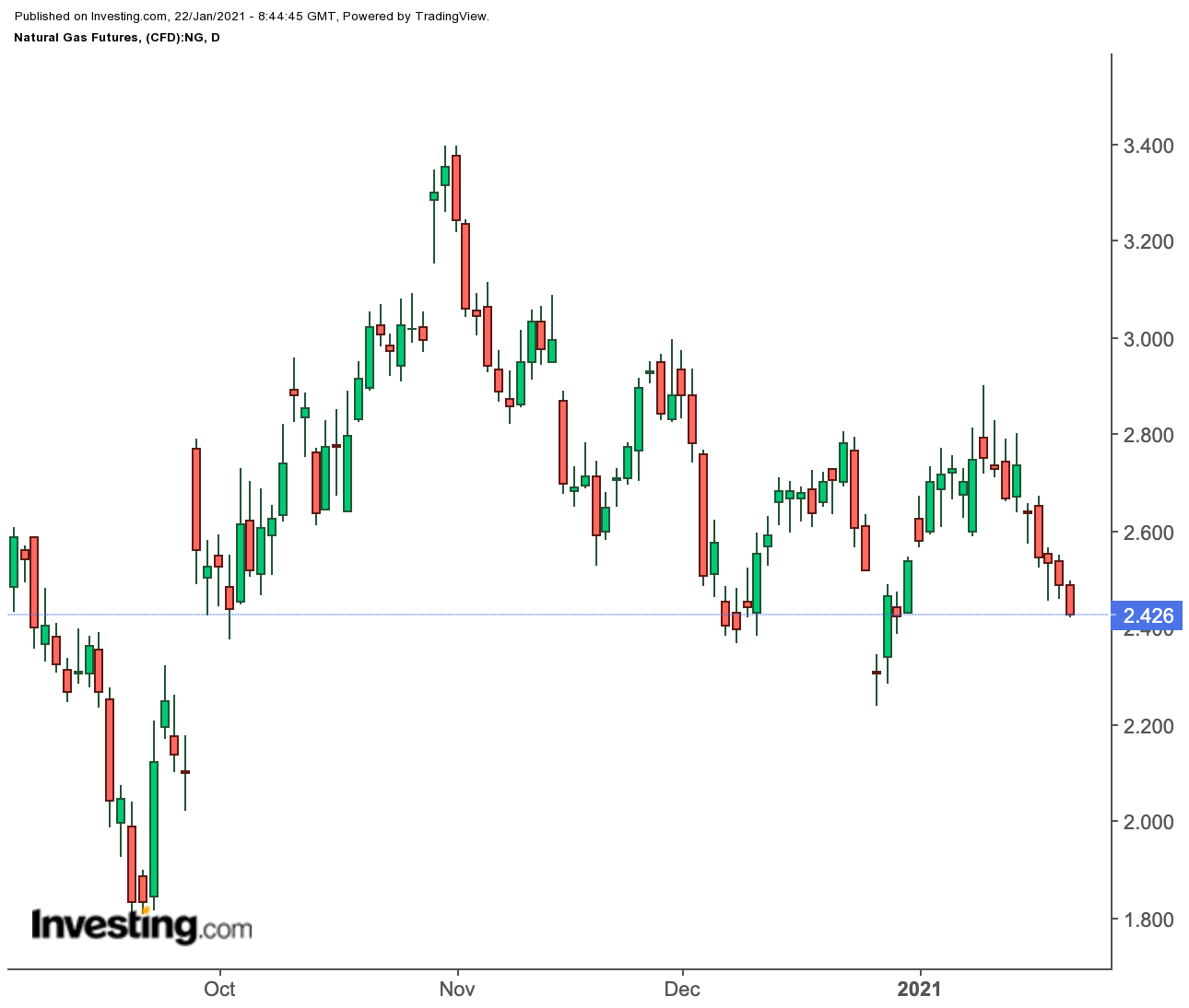They say a week is a long time in politics. In natural gas, a week can wipe you out.
In just five days, Henry Hub futures lost 9% to flip all gains made over the past three weeks and return to near lows not seen since the week of Christmas.

Those who’ve been in this game long enough will know that a 9% weekly move is nothing in the world of natural gas volatility.
Yet, what makes this swing interesting is that it occured in a week when the weather was mixed, and trending towards warmer-than-usual.
And that’s probably what tipped the market’s balance from the bulls to the bears—the lack of sustained cold to generate the kind of heating demand that natural gas needs all the more now, since LNG, or liquefied natural gas, is its only dependable demand component.
Mild Weather Catalyst For Rout
Unless appropriate and consistent chill arrives soon, Henry Hub’s front-month contract—which settled Thursday at just under $2.50 per mmBtu, or million metric British thermal units—may be vulnerable to a bottom deeper than the Christmas low of $2.24 per mmBtu, said Gelber & Associates, a Houston-based consultancy that specializes in gas market risk.
It adds:
“Mild weather in the current week has hindered demand. Additionally, weather models continue to confirm the outlook for a warmer than normal start to February, centered in the middle of the country and extending to the east.”
The Gelber assessment comes as the trade awaits the US Energy Information Administration’s gas storage report for the week ended Jan. 15, due at 11:00 AM ET (1600 GMT).
The consensus among analysts is that there was a draw of 174 bcf, or billion cubic feet, from storage last week versus the previous week’s 134 bcf.
Outsized Weekly Draw Expected, Despite Demand Concerns
By all accounts, the EIA will be releasing a fairly bullish gas storage report if the analysts are on target. That’s because inventories fell by just 97 bcf during the same week a year ago and the five-year (2016-2020) average withdrawal for the period is 167 bcf—still about 7 bcf below the current estimate.
What’s quite baffling is that such an outsized draw should come during a week when the weather was warmer than usual. According to data from Refinitiv, there were 182 HDDs, or heating degree days, for the week, compared with a 30-year normal of 202 HDDs for the period.
HDDs are used to estimate demand to heat homes and business, and measure the number of degrees a day's average temperature is below 65 degrees Fahrenheit (18 degrees Celsius).
LNG Woes Added To Weight On Market
But there may be a reason why trade was spooked enough to sell down gas this week—a market disruption in LNG shipments—said Scott Shelton, energy futures broker at ICAP in Durham, North Carolina.
LNG feedgas flows had fallen off in recent days and were estimated at near 9.5 bcf, mainly due to a drop in production at the Sabine Pass processing terminal. It’s unclear what exactly was behind the decrease, although reports of dense sea fog along the Gulf Coast and maintenance at nearby compressor stations have been cited.
ICAP’s Shelton said funds were heavy sellers in gas this week after the drop in Sabine output. He adds:
“I don’t see additional selling for the time being. Perhaps my (price) range of $2.55 to $2.85 was too high for the front (month), but I am sticking with that concept for the summer.”
Shelton may be somewhat right.
Forecasters are predicting a solid surge of cold next week, though freezing temperatures are not expected to extend as far as previously thought or last as long, naturalgasintel.com said in a blog on Thursday.
According to the blog, as recently as last week, meteorologists were anticipating a polar vortex—a cold snap that develops in the atmosphere above the North Pole and sends harsh blasts of subzero temperatures throughout the Northern Hemisphere. This could have pushed the anticipated freeze as far south as Texas and enabled the cold to last well into February.
But meteorologists have since backed off polar vortex expectations, and a warming pattern is projected to return by early next month, impacting demand for gas-powered heating, the blog said.
It also quoted Maxar’s Weather Desk as saying:
“Over the first few days of February, above average temperatures are likely to be widespread from the Rockies to the Midcontinent and Northeast, including a couple days of much aboves in the Midcontinent. Belows fade in the East early, giving way to aboves in the latter part of the period.”
Price Forecast At “Strong Sell” Now But Could Change
Back to gas prices, Investing.com’s Daily Technical Outlook has turned to a ”Strong Sell” for Henry Hub’s front-month February contract, versus the “Strong Buy” of the previous week.
Should the contract extend its bearish trend, a three-tier Fibonacci support is forecast, first at $2.464, then $2.443 and later at $2.408.
Should the trend turn positive, then a three-stage Fibonacci resistance will likely be first at $2.534, then $2.555 and later at $2.590.
In any case, the pivot point between the two is $2.499.
As with all technical projections, we urge you to follow the calls but temper them with fundamentals—and moderation—whenever possible.
Disclaimer: Barani Krishnan uses a range of views outside his own to bring diversity to his analysis of any market. He does not own or hold a position in the commodities or securities he writes about.
